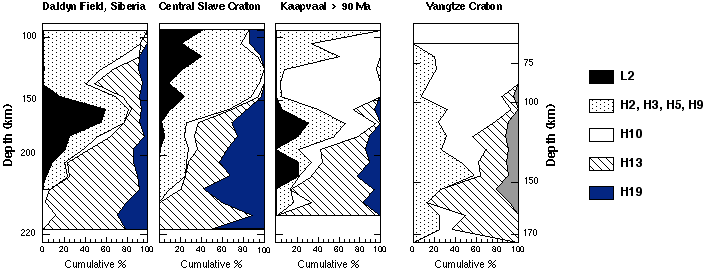MAPPING the Subcontinental Lithosphere with Garnet Populations
W.L. Griffin1,2, Suzanne Y. O'Reilly1, N.I. Fisher1,1,3, J. Friedman1,4, C.G. Ryan1,2 and E. van Achterbergh1
1GEMOC Macquarie
2CSIRO Exploration and Mining
3CSIRO Mathematical and Information Sciences
4Dept. of Statistics, Stanford University
A statistical analysis of >12,000 analyses of garnet xenocrysts has revealed significant differences related to the tectonothermal age of the crust penetrated by the host volcanic rock [1]. To explore these differences, we are developing new statistical approaches to define natural populations in the garnet database. Some preliminary results are presented here to show the power of the method. CARP (Cluster Analysis by Recursive Partitioning) compares the real data with a "null" Monte Carlo set containing only clusters based on concentrations in each variable, to define clusters in the real data. We have identified 12 populations, accounting for 75% of the data. Comparison with xenolith data suggests that these populations represent consistent combinations of features produced by both primary depletion and later metasomatic modification. The correlation of some populations with xenolith types is shown below, with examples of their distribution in SCLM sections. Each garnet grain has been assigned to a CARP population, and placed in depth context by reference of a nickel-based equilibration temperature ( TNi ) to the localgeotherm.
Archean SCLM sections tend to be strongly stratified, and the
degree of depletion decreases downward. The Slave craton is an extreme
example of this type, with a highly depleted upper part separated from
a more lherzolitic lower part by a boundary zone <10 km thick; this
structure has been mapped across >12,000 km2 [2]. The Kaapvaal craton SCLM
is less depleted but still markedly layered; granular phlogopite-bearing
lherzolite (H10A population), which is a minor rock type in the Dalydn
and Slave sections, is abundant at shallow depth, while deformed and metasomatised
lherzolites (H13 garnet population) increase with depth. Proterozoic
sections such as the Yangtze craton show a smaller range of rock types;
harzburgites are rare, and stratigraphic layering is less pronounced. Typical
Phanerozoic
SCLM (not shown) is dominated by fertile spinel lherzolites, most of
which have undergone <10% melt extraction; 90% of the garnet peridotites
in these sections (typically near the base, due to high geotherms) classify
as H10B, and are even less depleted than the spinel lherzolites.

| class | Fo | Depleted Xenolith Types |
| L2 | 93.5 | Subcalcic harzburgites, |
| H2 | 91 | Mg-rich pyroxenites, low-Cr lher\zzolites |
| H3 | 92 | Depleted granular lherzolites. |
| H5 | 92.5 | Depleted granular lherzolites ±phlogopite |
| H19 | 92.5 | Depleted granular and sheared lherzol. lhezliteshez\lherzzolites |
| H21 | 92.5 | Refractory lherzolites, cryptic metsom. |
|
class |
Fo | Fertile Xenolith Types |
| H9 | 89.5 | Fe-rich coarse lherzolites (rare) |
| H10A | 92 | Phlogopite gran. lherz. ±phlogopite |
| H10B | 89.5 | Very fertile granular lherzolites |
| H13 | 90.5 | Fertile lherzolites, mostly sheared |
| H15 | 91.5 | Mildly depleted granular lherzolites |
| H27 | 88.5 | High-T sheared lherzolites |

 GEMOC ARC National Key Centre
GEMOC ARC National Key Centre